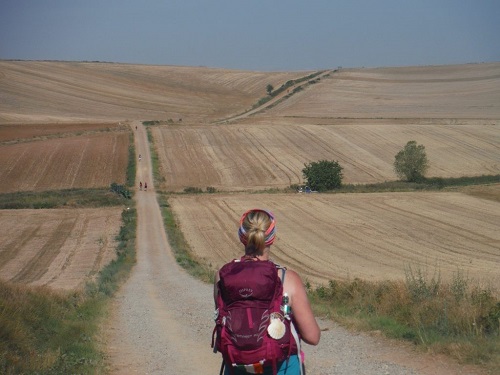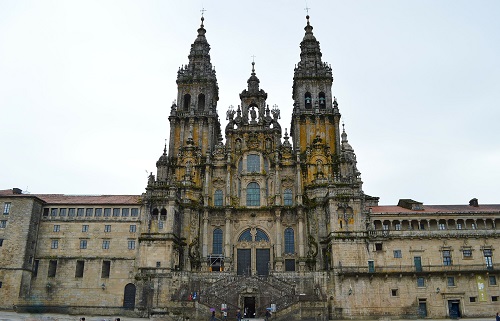Blog del Instituto Cervantes de Dublín
Torre Martello
Los irlandeses y el Camino de Santiago | The Irish and the Way of St. James

Hoy en día, el Camino de Santiago es conocido como una de las rutas más populares de toda Europa, que atrae cada año a miles de peregrinos y turistas. Tras la consagración de los restos de Santiago en el año 813 d. C. por el obispo de Iria-Flavia y el crecimiento de la peregrinación bajo los reyes de León y de Castilla a lo largo de la Alta Edad Media, el Camino se convertiría en la tercera ruta peregrina más importante del mundo. No obstante, lo que quizás no conocemos bien en Irlanda es la historia de los peregrinos irlandeses y la importancia de la práctica de ir en peregrinación dentro del contexto europeo de la Edad Media.
Según las últimas investigaciones, los primeros peregrinos irlandeses eran monjes Benedictinos o Agustinos que residían en monasterios fuera de Irlanda, mayoritariamente en Alemania y Francia. Ahora, la mayoría de los historiadores coinciden en que la primera ruta fija entre Irlanda y España se estableció durante la Alta Edad Media, según demuestran las conchas (el famoso símbolo de la peregrinación) localizadas durante las excavaciones de los dos antiguos monasterios de Tuam y Mullingar. Aunque la ruta entre Irlanda y España no era tan accessible durante esa edad temprana, el desarrollo del culto al apóstol Santiago empezaba a arraigarse más claramente dentro de la mentalidad religiosa irlandesa. Cabe recordar que la famosa ‘Puerta de Santiago’ (St. James’ Gate) de Dublín toma su nombre de los hostales de peregrinos que se construían a lo largo de la ribera del río Liffey en los que se hospedaban los peregrinos antes de viajar al norte de España.
Sin duda alguna, los siglos XVI y XVII suponen un nuevo capítulo en el desarrollo del culto al apóstol en Irlanda. Es decir, tras la llegada de la nueva alianza católica entre los jefes irlandeses y la España de Felipe II a finales del siglo XVI, los vínculos se volvían cada vez más fuertes. Además, con la inauguración de los llamados Años de Jubileo de la Iglesia católica, establecidos con el objetivo de obligar a los creyentes a ir en peregrinación, y debido a la apetura de nuevas rutas marítimas entre Irlanda y Galicia, no costaba tanto viajar. Además de desarrollar los lazos políticos y religiosos entre Irlanda y España, el Camino de Santiago ofrecía a los peregrinos irlandeses una posibilidad de viajar y de vivir una nueva experiencia.
A pesar de la caída del número de peregrinos debido a las leyes anticatólicas del siglo XVIII y XIX, el culto al apóstol permanecía lo suficientemente afianzado como para resistir la opresión religiosa. Con el paso del tiempo, la peregrinación iba abandonado un lugar predominante dentro de la práctica religiosa, gracias a la preocupación más existencial del catolicismo irlandés. Sin embargo, la fuerza de la memoria cultural de los siglos anteriores logró mantener la importancia del apóstol Santiago, así como cierta querencia hacia el Camino.
Hoy en día, viajan miles de irlandeses anualmente a Francia, Portugal y España para empezar su camino hacia Santiago por razones muy distintas. Mientras que la religión ya no es el único motivo para ir en peregrinación como lo era durante la Edad Media, los irlandeses que emprenden este viaje hoy lo hacen con una misma meta, llegar a Santiago y vivir una experiencia de desarrollo personal. A lo largo del camino, estos mismos irlandeses pueden conocer y entender los vínculos que todavía hoy existen entre Irlanda y Galicia así como el patrimonio compartido de las naciones célticas.
Ante la situación de movimiento restringido al que nos enfrentamos ante la COVID-19, merece la pena redescubrir uno de los rincones más irlandeses de España; el Camino de Santiago.
Texto: Philip McGuinness
Today, the Camino de Santiago is known as one of Europe’s most popular walking routes, attracting thousands of pilgrims and tourists every year. Following the consecration of the remains of St. James by the Bishop of Iria-Flavia in Galicia in 813 B.C. and the growth of pilgrimage to Santiago under the patronage of the monarchs of León and Castilia throughout the High Middle Ages, the ‘Camino’ grew to become the world’s third most important pilgrimage route. Nevertheless, what still remains to be fully understood in Ireland is the story of Irish pilgrims and the importance of pilgrimage to Irish Christians in the context of the European religious context of the High Middle Ages.
According to the latest historical research, the first Irish pilgrims to Santiago were Benedictine or Augustinian monks residing in European monasteries, mainly in France or Germany. Nowadays, historians agree that the first mass pilgrim route between Ireland and Spain was established during the High Middle Ages (12th or 13th centuries), as the discovery of pilgrims shells in excavations of the monasteries of Tuam and Mullingar appear to show. Although this route between Ireland and Spain was not immediately accessible during this early period, the cult St. James began to embed itself firmly within Irish Christian practice. Thus, it is worth remembering that Dublin’s ‘St James’ Gate’ takes its name from the ‘pilgrim hotels’ established along the banks of the River Liffey which housed Irish pilgrims before they set off for Spain during the 12th and 13th centuries.

Later on, the 16th and 17th centuries signalled a new chapter in the development of the cult of St. James in Ireland. That is to say, with the coming of the Catholic alliance between Ireland’s Gaelic chieftains and Philip II of Spain, the connections between Ireland and Spain grew ever stronger. Moreover, after the designation of so-called ‘Jubilee Years’ by the Catholic Church, introduced to require Christians to undertake regular pilgrimages, and the opening of sea routes between Ireland and Spain, it was no longer so difficult to travel between the two countries.
Despite the fall in pilgrim numbers owing to the impositions of the Penal Laws of the 18th and 19th centuries, the cult of St. James remained sufficiently embedded as to resist the religious oppression of the time. With the passing of time, the idea of pilgrimage thus came to occupy a lesser position within Irish life, such was the more existential concern of the Catholic Church. Nonetheless, the strength of cultural memory of previous centuries ensured the place of St. James and with it, a certain fondness of the Camino de Santiago. Today, thousands of Irish men and women travel to Portugal, France and Spain for different reasons to begin their journey to Santiago. Whilst religion is no longer the sole reason for doing so as it was during the Middle Ages, the Irish who undertake this journey today do so with the same goal; to reach the city of Santiago and to undergo a process of personal development. Along the way, these Irish men and women come to discover and understand the enduring connections between Ireland and Galicia and with it the shared heritage of Celtic nations. With the restrictions we are all facing at present, it is worthwhile rediscovering one of the most Irish corners of Spain: the Camino de Santiago.
Text by Philip McGuinness
Entradas relacionadas
Etiquetas
Camino de Santiago España Galicia historia; History Irish-Spanish relations Irlanda relaciones hispano-irlandesas Religion religión St. James Way Tourism turismo



